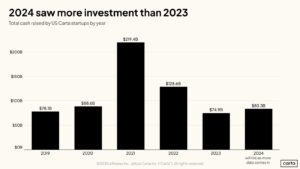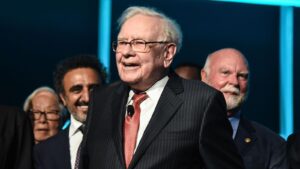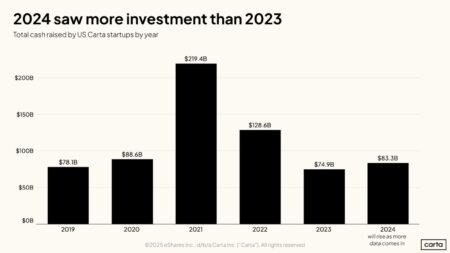By Rieva Lesonsky
Last year, we noted a “ workplace revolution” was probably on the way. While 2024 experienced much of that revolution, the culmination will likely be in 2025. AI has already had a significant impact in the workplace, and more change will surely come.
The demand that American workers return to the office continues despite technological advancements that make working from home more secure and easier than ever.
America’s employees are not happy. Gallup calls the current “shift” workers are experiencing the “ Great Detachment.” According to Gallup, “For employers, this means that while turnover numbers may have slowed, employee productivity concerns and future talent loss are hidden organizational risks.” And it adds that when employees feel detached from their jobs, they are indifferent or resistant to workplace change.
I spoke to human resources and workplace experts for this article to find out how small businesses can continue to win the workplace revolution.
Workplace and Hiring Predictions for 2025
Hiring Trends
The Consolidation of Employee Acquisition and Management Functions
There is a lot in store for the HR industry in 2025. Talent acquisition and management functions will continue consolidating, driving greater efficiency and alignment. Internal talent marketplaces will gain traction as organizations prioritize internal mobility, supported by the mainstream adoption of skill taxonomies from platforms like Workday and other HCM (human capital management) providers.
Generative AI will become a standard tool for creating hiring content, including job descriptions, interview questions, assessments, and pre-screens. Data will remain a critical asset, with businesses leveraging it to drive decisions. Finally, AI-driven streamlined hiring processes will increasingly outpace traditional validated processes as speed and efficiency become paramount in securing top talent.
—Dr. Nathan Mondragon, Chief Innovation Officer, HireVue
How Can Small Businesses Attract Corporate Refugees?
Talent recruitment and retention may continue to be an issue in 2025. With the ongoing talent shortage, small businesses could continue to benefit from workers leaving larger corporations seeking better work-life balance. Small businesses already have an advantage, as more employees move from big companies to small ones than the other way around.
We predict this trend could continue as small businesses can offer flexible work arrangements, greater opportunities for responsibility and growth, and the ability to be more agile to [unhappy corporate workers]. However, the competition for talent will remain fierce, and small businesses will need to embrace more creative recruitment strategies as many still rely heavily on word-of-mouth referrals. Notably, 38% of small businesses don’t use digital tools for recruitment.
—Tyler Peterson, Head of Professional Risks, Hiscox USA
Are You Relying Too Much on Referrals?
The over-reliance on referrals is a trend I’d like to see businesses evolve from. Referrals are great because they allow us to hire a more or less “known quantity,” but they don’t do much to diversify the talent pool. It also means that you’re hiring people who may not challenge the team as much as if you brought in an outsider/someone you haven’t worked with before.
—Sibyl McCarley, Chief People Officer, HireVue
Top Recruiting Trends for 2025
As we step into 2025, the recruiting world continues to evolve, shaped by economic forces, emerging technologies, and shifting workforce dynamics. In our recently released Top Recruiting Trends for 2025 report, we identified four key trends that will define talent acquisition in the coming year. Here’s what to look for:
• Labor market normalization—The Federal Reserve’s interest rate cuts and immigration’s impact on labor supply are rebalancing the labor market, offering new opportunities for efficiency in hiring.
• Artificial intelligence in recruiting—AI innovations like chatbots, job-matching tools, and automated interviews enhance recruitment processes; balancing technology with human interaction is critical to avoid bias and ensure successful adoption.
• Quality retention over quantity—Companies are moving beyond retention for retention’s sake, focusing on cultivating engaged, high-performing teams.
• Data-driven recruitment marketing—The softer economy demands more scrutiny of budgets, metrics, and strategies. Businesses need to identify gaps and optimize their recruitment processes to align with their goals.
—Matt Gilbert, VP of Employer Brand Strategy, Appcast
Employee Experience
Personalizing the Employee Journey Is the Key to Navigating a Multigenerational Workforce
In today’s diverse workplace, multiple generations—baby boomers, Gen X, millennials, and Gen Z—work side by side, bringing unique perspectives and needs to the table. HR can play a pivotal role in personalizing the employee journey to cater to each generation’s preferences and expectations.
For boomers who value stability and face-to-face communication, HR can offer mentorship programs and knowledge-sharing opportunities. Gen X employees, known for their independence and work-life balance priorities, may benefit from flexible work arrangements and personalized professional development opportunities. Millennials, who seek purpose and continuous feedback, can be engaged through meaningful work, regular conversations with their managers, and clear career advancement paths. Gen Z, known for their passionate support of social causes and desire for prompt feedback, thrives in companies with strong employee resource groups (ERG) and individualized attention.
HR can leverage AI to provide personalized learning paths, real-time feedback, and digital communication platforms. By understanding and addressing the distinct needs of each generation, HR can create a more inclusive, engaging, and productive work environment for all employees.
—Rebekah Roberts, Learning and Development Program Manager, University of Phoenix
The “Employee First” Approach—Enhancing Employee Experience
Employee experience is increasingly central to HR, focusing on holistic approaches to improve engagement and well-being. Key highlights include:
• Personalized experiences—Businesses are moving towards implementing more personalized experiences, such as tailored leadership development programs, personalized coaching, benefits, and well-being programs that address mental, physical, and financial well-being.
• Increased employee flexibility—Flexible work policies are crucial for maintaining work-life balance. Remote and hybrid work models, compressed workweeks, flexible working hours—these trends underscore a shift from rigid, one-size-fits-all policies to adaptable frameworks that respect individual needs and encourage a more balanced workforce. Productivity analytics has also taken center stage, driven by the need to reassess workforce productivity.
• Streamlining technology and tools—As employees navigate complex information and tasks across multiple systems, simplifying these interactions is essential for keeping them engaged and productive. Human-guided AI plays a vital role here by enhancing accessibility and efficiency through conversational interfaces, such as virtual assistants and chatbots. By creating a seamless, journey-like experience for employees, AI can improve employee satisfaction and foster a more efficient and engaged workplace.
—Annie Varghese, Director HRIS and HR Analytics, University of Phoenix
Investing in Employee Well-Being
• Holistic well-being: mind, body, and purpose: In 2025, workplaces will embrace a more comprehensive view of well-being by integrating mental, physical, and purpose-driven initiatives. As companies truly embrace holistic well-being, we’ll continue to see more employer-provided insurance programs offering tools for certain populations as companies truly embrace holistic wellbeing.
• Emphasis on social connection: Isolation in hybrid and remote setups has underscored the importance of fostering social connections at work. A sense of belonging is being recognized as vital to employee satisfaction. As remote and hybrid work remain the norm, we’ll continue to see businesses weave social well-being into the fabric of work through team-building retreats, in-person collaboration days, and virtual spaces designed for casual interactions.
• Financial well-being takes the stage: With economic uncertainties and the rise of gig and remote work, employees are increasingly seeking financial security. Companies will address this by offering personalized financial planning, salary transparency, and benefits like debt counseling.
• The ROI of well-being: Investing in employee well-being is a new concept. Employers who have taken the time to commit to well-being in the workplace know it’s a strategic need to have. As we enter 2025, the companies prioritizing well-being will thrive, setting a standard others will aspire to follow.
—Maryalice Giroux Viljoen, VP of Administration and Talent, QED Investors
More from AllBusiness:
Using AI to Analyze Your Team’s Skill Sets
AI-enabled skills management has become a critical tool in HR, with applications across learning, development, and talent acquisition. AI can help identify gaps by analyzing employees’ skill sets, recommending reskilling or upskilling pathways, and facilitating personalized career pathing. This approach also supports effective hiring and sourcing by matching candidates with roles that align with their strengths while fostering ongoing skill development within the workforce.
In internal talent marketplaces, these skill insights enable businesses to match employees to gig and project work, enhancing agility and strategic workforce planning. Employees benefit from expanded internal mobility and experiential learning opportunities, allowing them to gain diverse experiences that advance their careers.
There is also an emphasis on building collective intelligence to solve skills gaps by developing expertise directly from employees’ daily work. This helps employees at lower levels have a good knowledge and understanding of the skills they need to develop for their career growth.
This integrated approach to skills management and talent marketplaces enhances productivity, leads to more qualified hires, and builds a resilient, adaptable workforce for evolving business needs.
—Shruthi Kumar, Senior Director HR Technology and Employee Services/Annie Varghese, Director HRIS and HR Analytics, University of Phoenix
Coaching Employees
Automated Coaching Adapts to Employee’s Needs
We anticipate a shift from broad, role-based development programs to highly contextualized, AI-driven coaching that adapts to employees’ needs in real time. We believe the future lies in organically integrating employee development into the workday, where your team receives quick, relevant insights precisely when they need them.
Rather than relying on scheduled sessions or one-size-fits-all programs, digital tools like automated coaching use AI to analyze unique team dynamics and deliver personalized, scenario-specific guidance to improve collaboration, communication, and performance outcomes.
We’re also closely watching the rise of micro-coaching, where coaching is delivered in one- to two-sentence nudges that take seconds to absorb. This approach is increasingly critical as organizations grapple with “change fatigue,” with 73% of HR leaders reporting employee burnout from constant adaptation.
By embedding short, impactful coaching moments into platforms like Slack, Teams, and email, automated coaching enables continuous learning that feels seamless and actionable, building workforce agility that aligns with both short- and long-term organizational goals.
—Darrin Murriner, Co-founder and CEO, Cloverleaf
About the Author
Rieva Lesonsky creates content focusing on small business and entrepreneurship. Email Rieva at [email protected], follow her on Twitter @Rieva, and visit her website SmallBusinessCurrents.com to get the scoop on business trends and sign up for Rieva’s free Currents newsletter.
Read the full article here











